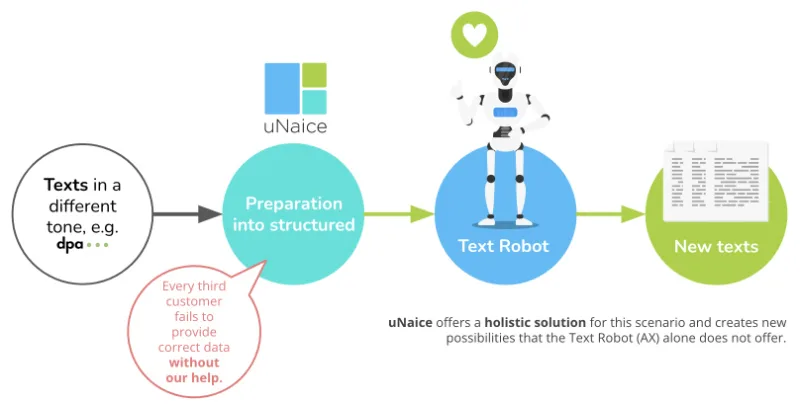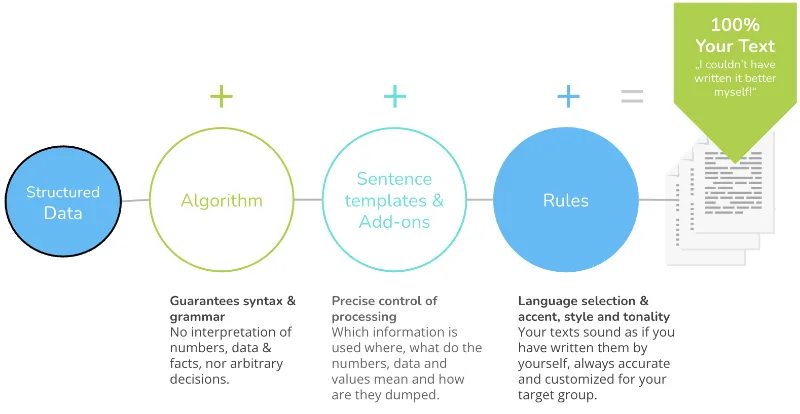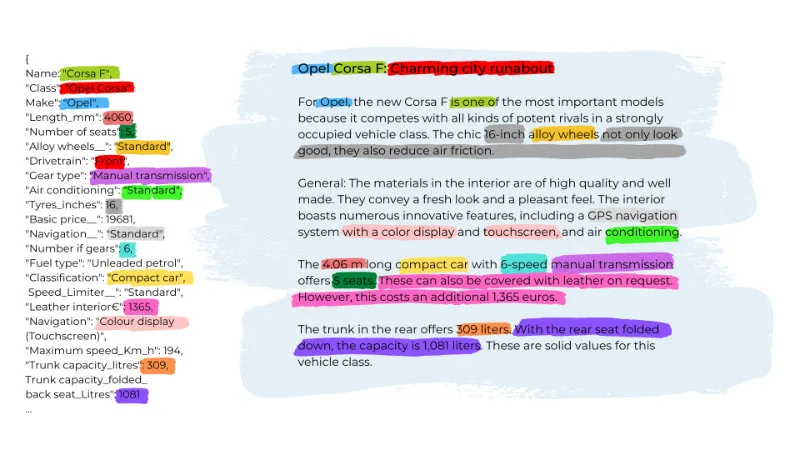Data Management for Your Business: How to Harness the Potential (Part 2)

In the previous article, we showed how operators can implement a sensible data strategy. In the following article, however, we will take you by the hand and guide you through the world of structured data. What is structured data and how does it differ from its unstructured namesake? How are they essential for efficient data management and how can you use them strategically to grow your business?
Let’s discover together how you can effectively use structured data in your company to improve your business processes and increase profitability.
Contents
- Optimized product data for flawless automated content generation
- Frequency and filling level
- Importance exceeds number
- How the text robot works
- What is unstructured data?
- The algorithm of the text robot
- No structured data basis available?
- Turning data into continuous text: What the text robot can do
- Meta data
- The text robot can do that too
Structured data
If the data basis is correct
The be-all and end-all for successful automated text generation by the text robot remains well-structured data, i.e. the right data basis. Part of this consists of product data, which is usually available from product marketing. This area contains an incredible amount of information (data) about the product that is just waiting to be used for content automation.
However, by no means all product data that a company can provide is suitable for machine evaluation and use by the text robot. The data field must have certain properties that are only provided by formatting. Only then can the Text Robot create beautiful texts automatically. In this context, beautiful means: informative, unique, SEO-optimized, with added value and grammatically (but also semantically) correct. What is important here is the consistent form, which must run through the entire data set. There is no other way to generate good automatic content.
Nevertheless, keep in mind that structured data makes sense even without content automation, as it is easier to process and can be queried more easily by both machines and humans. They are becoming more usable overall, while data integrity, i.e. truthfulness, remains a major must on the web.

Optimized product data for flawless automated content generation
Shop owners often have master data anyway, such as product descriptions, product names or manufacturers, which already contain the most important characteristics (e.g. color, material, dimensions) in a single data field. As practical as this may be for a header (because customers can see the product features straight away), it is useless for the text robot. As the data usually comes from different sources, this often results in even more data chaos. This must be avoided, regardless of whether you decide to use content automation or not. As mentioned above, unstructured data never makes sense.
Rich data fields contain a lot of wasted information. Why? Because the attributes contained therein cannot be read out in a differentiated manner. If, on the other hand, there is a separate data field for each attribute (property) ([Material], [Maße], [Farbe]), a separate sentence can be created for each individual attribute, which in turn is rewritten using several variants, orders and synonyms. This results in a rich variance that excludes duplicate content from the very beginning.

Conclusion: The more fine-grained the data is (the more data fields with clear fillings I have), the more multifaceted, detailed and flexible the automatic texting will be.
Because that is exactly what structured data is! Making the data chic in this way may seem a little time-consuming at first, but it’s definitely worth it, because it’s the only way (!) to automatically create great sales-boosting texts that your customers will love.
Frequency and degree of filling
Granularity is important, but there is no point in creating data fields that only relate to a few products. Here, it is important to consider which attributes apply to as many products in the range as possible. The degree to which the respective attributes are filled is just as important. In other words: How many values does the attribute contain?
You have to imagine it as follows:
Importance trumps number
In some cases, it can make sense to use only sparsely filled attributes for the Automated Content, namely if these attributes represent a special feature that should be emphasized.
Example:
The iridescent bead appliqué makes this T-shirt a real eye-catcher.
If this category is particularly important for your store, then the corresponding attribute must be displayed, even if you only offer a few T-shirts of this type.
Individual data fields can of course refer to several products. Data from completely different products can also be included in a data set. This makes scalability super easy.
The “Operating system” data field for a desktop computer can contain the entry “Windows 10”, for example. That’s absolutely ok for the text robot.
How the text robot works
The text robot is actually like a content department. Like them, it needs product data as a source of information in order to generate meaningful texts. If these are available, it combines them with the right content and produces complete texts from them. But this requires data to be prepared. It is this preparation that results from sensible data management.
What is “correct content”?
These are prefabricated sentence frameworks on which the text robot relies. As long as the data basis is correct, there will never be any unwanted text with incorrect content. There is no need to proofread and check each individual text before publication. This saves an enormous amount of time, costs and many other resources that can be used for other purposes.
Now that you know what structured data is, let’s take a look at exactly how it becomes an informative text.

The colored text section is an enhancement of the sentence that results from the data, but is not found in the data in this form. This means that the text robot does not simply assemble data. It goes beyond this and also incorporates interpretations in the right place if data is not self-explanatory.
This feature is an enormous advantage, especially for data that requires explanation, which can occur with both complex and simple products. If we look at the example above, the speed index Q alone says nothing at all for prospective customers who don’t know much about cars and engines. What often happens in these cases? They first research the meaning and then end up at the competition, where they may decide to make a purchase.
This is of course an absolute no-go and should be avoided at all costs. This can be prevented by the interpretation of the text robot.
Result: The text robot generates 100% correct texts – completely without AI, but just as automatically!
What is unstructured data?
A counter-example is very useful for a better understanding of structured data:
- the color “blue” is marked for a red dress
- empty fields
- some cars have “5” seats, while the rest have “five”
Conclusion: The text robot cannot work well with irregularities of any kind or empty fields. They make its work more difficult and cannot be used in any other way.
Aside from the text robot, unstructured data has the following negative aspects:
- they cannot be used by potential customers
- they cannot be identified by Google and other computer programs or can only be identified poorly
- they complicate any workflow
- all analysis and processing options are made more difficult
With structured data, on the other hand, all information is provided in standardized data fields, making it easy to retrieve and use.
The algorithm of the text robot
The algorithm determines the syntactic and grammatical framework of the texts. Unlike an AI, the text robot does not make any unauthorized decisions or write any unauthorized interpretations. Therefore, the generated texts always correspond to the client’s ideas.
Sentence templates and sentence enhancements
Sentence templates and sentence enhancements result in sample texts that are expanded with a number of synonyms, phrases and additions that provide a great deal of variance with lots of informative content that also embellishes the text.
Set of rules
By using precise sets of rules, texts sound as if you had written them yourself. We define in advance exactly which rules are necessary to ensure that the texts meet your exact requirements in terms of language selection, coloring, style and tonality.

Data like a cloze
If the data is maintained correctly, it will also be displayed correctly in the text later on.
In practical terms, you can imagine it as a cloze text, with the text robot inserting the correct attributes into the provided gaps.
No structured data basis available?
You are not alone with this problem. But don’t worry! A missing data structure is not an insurmountable obstacle.
While working with our clients, we take the data and check it for structure and completeness. An inadequate data basis can be brought back into shape by our intervention.
What is and remains important is to structure the data optimally so that it can be read by the machine. Fields with poorly differentiated multiple attributes and fields with continuous text often cannot be evaluated or used.
|
Nice to know: In addition to text automation, structured data offers many other possibilities. Curious now? Then book an appointment here and let our experts show you all the options. |
Turning data into continuous text: What the text robot can do
The text robot opens up a wide range of design options that are not limited to cloze texts in which prefabricated texts are filled with data. This is only the simplest task, which the text robot masters with ease.
Example: Opel Corsa
The following text is the beginning of a blog post about the Opel Corsa F, a charming city runabout.

A comparison of the data on the left and the final text on the right shows that some passages do not match. This is not a mistake, but rather a very deliberate adaptation so that the content flows naturally into the text and, ideally, provides further information for the reader. These are all interpretations that no longer have to be made by your readers on their own.
Information
1st example
The attribute value “Opel Corsa” (model series) turns into “charming city runabout” in the text.
If the model series were to be labeled “Opel Cascada”, then it could become a “sporty premium convertible” or something similar.
2nd example
The length in mm “4060” is expressed in meters in the continuous text “4.06 m”, as this length specification is simply more common. Conversions of this type into other units are no problem for the text robot and make the text more readable and up-to-date.
3rd example
The attribute “Tires_inch” with the value “16” results in the following sentence: “The stylish 16-inch aluminum rims not only look good, they also reduce air friction.” A separate addition is also used here.
4th example
“The trunk in the rear offers 309 liters. With the rear seat folded down, the capacity is 1,081 liters. These are solid values for this vehicle class.”
The last sentence is only given according to the if-then principle if the content is correct for the specified values. Three attributes are required for the rule:
- “Trunk volume_liter”
- “Trunk_volume_folded_back_seat_liter”
- “Vehicle class”
If one of the attributes, such as the vehicle class, is different and therefore no longer meets the specifications, either a different set is used (if these are very good values) or it is omitted all together.
Meta data
So-called meta data, such as sales figures, returns data, reviews from other buyers, store information, manufacturer data or similar, are of particular interest to large e-shops, as they allow the text robot to interpret information and offer additional added value.
A low return rate, for example, suggests that customers are extremely satisfied with the product. A sentence like the following can be used:
A particularly popular product that is guaranteed to provide you with joy for a long time.
The text robot can do that, too
To help you see what doors the optimization of your data opens up for you, we’ll give you a little insight here. In addition to product descriptions and magazine articles, the text robot can create many other texts with the right data basis.
Product comparison
In many e-shops, for example, it is already possible to compare two or more products.
This also works with the text robot, for example in continuous text, so that the specified products can be compared with each other in real time.
Camera example:
“… The key data make it clear: the Canon PowerShot SX500 IS easily wins the comparison. The winner’s sensor resolution, the flash features and the professional details are ahead of its rival.
Price trends for used cars
How do car prices change in relation to service life and mileage? This information can also be played out by the text robot.
Integration of registration statistics
External sources also provide helpful input for your text. Admission statistics, for example, offer a formidable opportunity for comparison. e.g:
- between different models: “In January, the Volkswagen ID3 sold better than the Volkswagen Golf.”
- with regard to a specific model or on a specific topic over a longer period of time: “The topic of electromobility is slowly arriving to the market.”
This can affect many other areas, e.g:
- Bicycles (speeds of e-bikes)
- Services
- Real estate
- and so on…
Conclusion
With intelligent data management and the use of structured data, companies can use data to their advantage. Sooner or later, this is guaranteed to lead to a decisive competitive advantage, as it is a very powerful tool that you can use to improve your website and optimize it for search engines. If you would like to know more about the use of structured data in the various use cases, we recommend reading our next article on “Data Management in Practice – The Example of Industries”.
